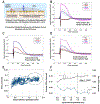Intracellular cardiomyocytes potential recording by planar electrode array and fibroblasts co-culturing on multi-modal CMOS chip
- PMID: 31494510
- PMCID: PMC8559116
- DOI: 10.1016/j.bios.2019.111626
Intracellular cardiomyocytes potential recording by planar electrode array and fibroblasts co-culturing on multi-modal CMOS chip
Abstract
Intracellular action potential signals reveal enriched physiological information. Patch clamp techniques have been widely used to measure intracellular potential. Despite their high signal fidelity, they suffer from low throughput. Recently, 3D nanoelectrodes have been developed for intracellular potential recording. However, they are limited by scalability, yield, and cost, directly constraining their use in monitoring large number of cells and high throughput applications. In this paper, we demonstrate intracellular potential monitoring of cardiomyocytes using simple 2D planar electrode array in a standard CMOS process without patch clamps or post fabricated 3D nanoelectrodes. This is enabled by our unique cardiomyocytes/fibroblasts co-culturing technique and electroporation. The co-cultured fibroblasts promote tight sealing of cardiomyocytes on electrodes and enable high-fidelity intracellular potential monitoring based on 2D planar electrode. Compared to existing technologies, our platform has a unique potential to achieve an unprecedented combination of throughput, spatiotemporal resolution, and a tissue-level field-of-view for cellular electrophysiology monitoring.
Keywords: CMOS; Cardiomyocytes; Cellular impedance sensing; Drug screening; Intracellular action potential recording; Multimodality sensor array.
Copyright © 2019 Elsevier B.V. All rights reserved.
Conflict of interest statement
Declaration of interests
The authors declare that they have no known competing financial interests or personal relationships that could have appeared to influence the work reported in this paper.
Figures





Similar articles
-
Optimizing Nanoelectrode Arrays for Scalable Intracellular Electrophysiology.Acc Chem Res. 2018 Mar 20;51(3):600-608. doi: 10.1021/acs.accounts.7b00519. Epub 2018 Feb 13. Acc Chem Res. 2018. PMID: 29437381 Review.
-
Nanocrown electrodes for parallel and robust intracellular recording of cardiomyocytes.Nat Commun. 2022 Apr 26;13(1):2253. doi: 10.1038/s41467-022-29726-2. Nat Commun. 2022. PMID: 35474069 Free PMC article.
-
A universal, multimodal cell-based biosensing platform for optimal intracellular action potential recording.Biosens Bioelectron. 2022 Jun 15;206:114122. doi: 10.1016/j.bios.2022.114122. Epub 2022 Feb 25. Biosens Bioelectron. 2022. PMID: 35245868
-
Intracellular recording of cardiomyocyte action potentials by nanobranched microelectrode array.Biosens Bioelectron. 2020 Dec 1;169:112588. doi: 10.1016/j.bios.2020.112588. Epub 2020 Sep 12. Biosens Bioelectron. 2020. PMID: 32956905
-
Multisite Intracellular Recordings by MEA.Adv Neurobiol. 2019;22:125-153. doi: 10.1007/978-3-030-11135-9_5. Adv Neurobiol. 2019. PMID: 31073934 Review.
Cited by
-
Advanced passive 3D bioelectronics: powerful tool for the cardiac electrophysiology investigation.Microsyst Nanoeng. 2025 Mar 17;11(1):50. doi: 10.1038/s41378-025-00891-w. Microsyst Nanoeng. 2025. PMID: 40097396 Free PMC article. Review.
-
Advances in non-invasive biosensing measures to monitor wound healing progression.Front Bioeng Biotechnol. 2022 Sep 23;10:952198. doi: 10.3389/fbioe.2022.952198. eCollection 2022. Front Bioeng Biotechnol. 2022. PMID: 36213059 Free PMC article. Review.
-
Intracellular Recording of Human Cardiac Action Potentials on Market-Available Multielectrode Array Platforms.Front Bioeng Biotechnol. 2020 Feb 18;8:66. doi: 10.3389/fbioe.2020.00066. eCollection 2020. Front Bioeng Biotechnol. 2020. PMID: 32133349 Free PMC article.
-
Cardio PyMEA: A user-friendly, open-source Python application for cardiomyocyte microelectrode array analysis.PLoS One. 2022 May 26;17(5):e0266647. doi: 10.1371/journal.pone.0266647. eCollection 2022. PLoS One. 2022. PMID: 35617323 Free PMC article.
-
Active Micro-Nano-Collaborative Bioelectronic Device for Advanced Electrophysiological Recording.Nanomicro Lett. 2024 Feb 27;16(1):132. doi: 10.1007/s40820-024-01336-1. Nanomicro Lett. 2024. PMID: 38411852 Free PMC article. Review.
References
-
- Abbott J, Ye T, Qin L, Jorgolli M, Gertner R, Ham D, and Park H, 2017. CMOS nanoelectrode array for all-electrical intracellular electrophysiological imaging. Nat. Nanotechnol 12, 460–466. - PubMed
-
- Aiba T, Shimizu W, Inagaki M, Noda T, Miyoshi S, Ding W, Zankov D, Toyoda F, Matsuura H, Horie M, and Sunagawa K, 2005. Cellular and ionic mechanism for drug-induced long QT syndrome and effectiveness of verapamil. Journal of the American College of Cardiology 45, 300–307. - PubMed
-
- Baumann R, Brischwein M, Schwinde A, Stegbauer K, and Wolf B, 1997. Monitoring of cellular behaviour by impedance measurements on interdigitated electrode structures Biosensor and Bioelectronics 12, 29–41. - PubMed
MeSH terms
Grants and funding
LinkOut - more resources
Full Text Sources

